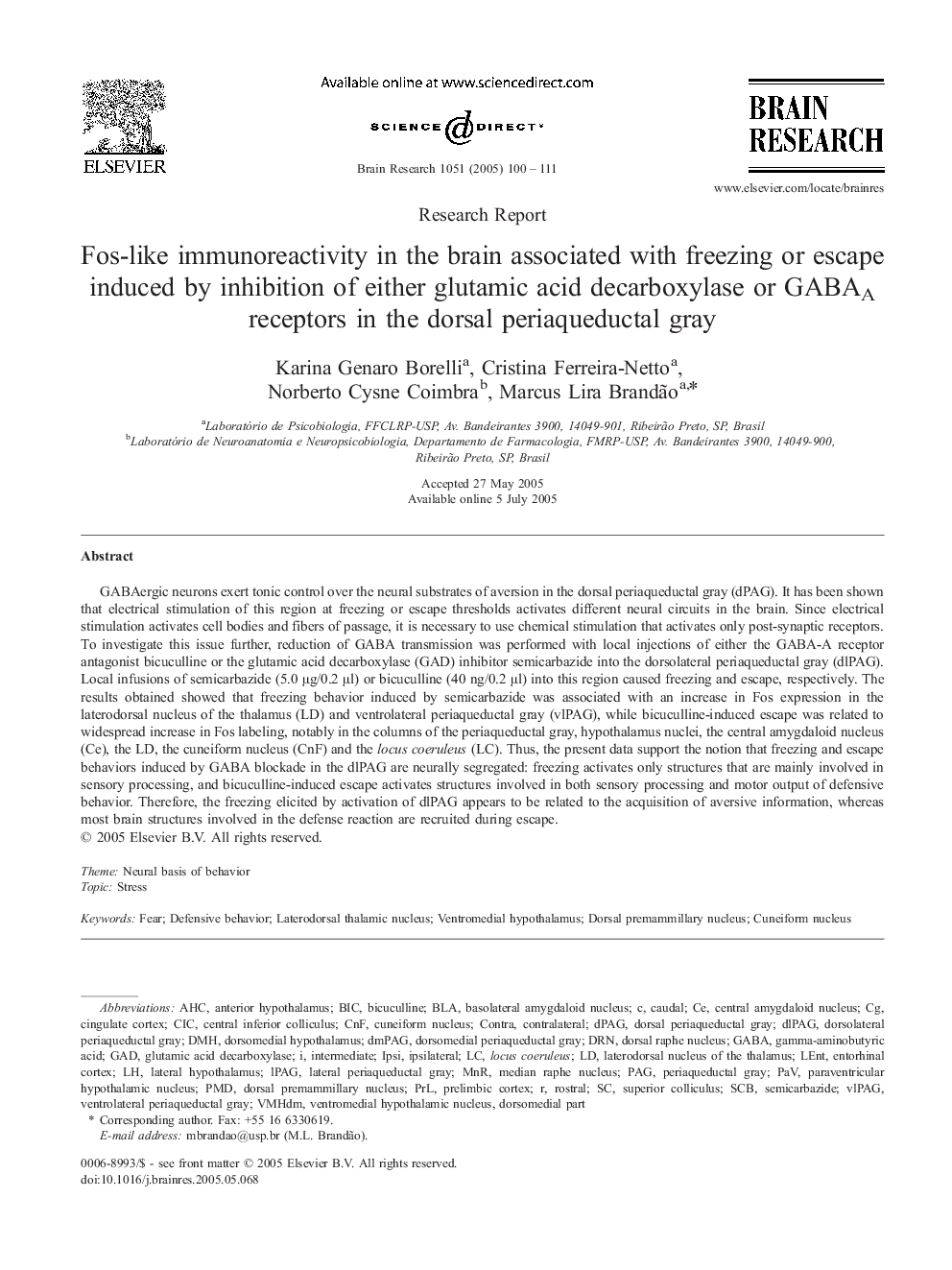| کد مقاله | کد نشریه | سال انتشار | مقاله انگلیسی | نسخه تمام متن |
|---|---|---|---|---|
| 9416056 | 1614329 | 2005 | 12 صفحه PDF | دانلود رایگان |
عنوان انگلیسی مقاله ISI
Fos-like immunoreactivity in the brain associated with freezing or escape induced by inhibition of either glutamic acid decarboxylase or GABAA receptors in the dorsal periaqueductal gray
دانلود مقاله + سفارش ترجمه
دانلود مقاله ISI انگلیسی
رایگان برای ایرانیان
کلمات کلیدی
CICdPAGdlPAGBicucullineDRNDMPAGCNFAHCGADDMHBLABICglutamic acid decarboxylase - glutamic acid dearboxylaseipsi - آنهاStress - استرس یا فشار روانیgamma-aminobutyric acid - اسید گاما آمینو بوتیریکintermediate - حد واسطdorsomedial periaqueductal gray - خاکستری پرایاکتومیdorsolateral periaqueductal gray - خاکستری پرایاکتیوال دو طرفهdorsal periaqueductal gray - خاکستری پرایکتون پشتی پشتیipsilateral - دو طرفهcontra - علیهlocus coeruleus - لوکوس سیرولئوسNeural Basis of Behavior - مبانی عصبی رفتاریbasolateral amygdaloid nucleus - هسته آمیگدولئید basolateralcuneiform nucleus - هسته خمیدهdorsal raphe nucleus - هسته رافهcentral amygdaloid nucleus - هسته مرکزی amygdaloiddorsomedial hypothalamus - هیپوتالاموس dorsomedialanterior hypothalamus - هیپوتالاموس قدامیcaudal - کادوcontralateral - کنتراستcingulate cortex - کورتکس کانگولتGABA - گابا
موضوعات مرتبط
علوم زیستی و بیوفناوری
علم عصب شناسی
علوم اعصاب (عمومی)
پیش نمایش صفحه اول مقاله

چکیده انگلیسی
GABAergic neurons exert tonic control over the neural substrates of aversion in the dorsal periaqueductal gray (dPAG). It has been shown that electrical stimulation of this region at freezing or escape thresholds activates different neural circuits in the brain. Since electrical stimulation activates cell bodies and fibers of passage, it is necessary to use chemical stimulation that activates only post-synaptic receptors. To investigate this issue further, reduction of GABA transmission was performed with local injections of either the GABA-A receptor antagonist bicuculline or the glutamic acid decarboxylase (GAD) inhibitor semicarbazide into the dorsolateral periaqueductal gray (dlPAG). Local infusions of semicarbazide (5.0 μg/0.2 μl) or bicuculline (40 ng/0.2 μl) into this region caused freezing and escape, respectively. The results obtained showed that freezing behavior induced by semicarbazide was associated with an increase in Fos expression in the laterodorsal nucleus of the thalamus (LD) and ventrolateral periaqueductal gray (vlPAG), while bicuculline-induced escape was related to widespread increase in Fos labeling, notably in the columns of the periaqueductal gray, hypothalamus nuclei, the central amygdaloid nucleus (Ce), the LD, the cuneiform nucleus (CnF) and the locus coeruleus (LC). Thus, the present data support the notion that freezing and escape behaviors induced by GABA blockade in the dlPAG are neurally segregated: freezing activates only structures that are mainly involved in sensory processing, and bicuculline-induced escape activates structures involved in both sensory processing and motor output of defensive behavior. Therefore, the freezing elicited by activation of dlPAG appears to be related to the acquisition of aversive information, whereas most brain structures involved in the defense reaction are recruited during escape.
ناشر
Database: Elsevier - ScienceDirect (ساینس دایرکت)
Journal: Brain Research - Volume 1051, Issues 1â2, 27 July 2005, Pages 100-111
Journal: Brain Research - Volume 1051, Issues 1â2, 27 July 2005, Pages 100-111
نویسندگان
Karina Genaro Borelli, Cristina Ferreira-Netto, Norberto Cysne Coimbra, Marcus Lira Brandão,